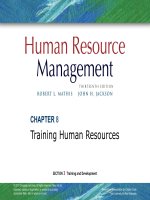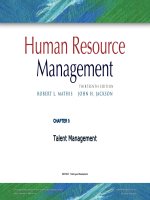Human resrouce management 12th mathis jacson chapter 002
Bạn đang xem bản rút gọn của tài liệu. Xem và tải ngay bản đầy đủ của tài liệu tại đây (1.74 MB, 45 trang )
CHAPTER 2
Strategic HR Management
and Planning
© 2008 Thomson/South-Western All rights reserved.
PowerPoint Presentation by Charlie Cook
The University of West Alabama
Chapter
Chapter Objectives
Objectives
After you have read this chapter, you should be able to:
■ Explain strategic HR management and how it is linked
to organizational strategies.
■ Discuss two possible contributors to competitive
advantage and how HR contributes to each.
■ Describe how legal, political, cultural, and economic
factors affect global HR management.
■ Define HR planning and outline the HR planning
process.
■ Describe the means for assessing the external and
internal
environments of HR management.
© 2008
Thomson/SouthWestern. All rights reserved.
2–2
Chapter
Chapter Objectives
Objectives (cont’d)
(cont’d)
After you have read this chapter, you should be able to:
■ Discuss several ways of managing a surplus and a
shortage of human resources.
■ Identify why HR metrics must consider both strategic
and operational HR measures.
© 2008 Thomson/SouthWestern. All rights reserved.
2–3
Nature of Strategy and HR Management
Strategy
Strategic HR Management
The proposition an
organization follows for how
to compete successfully and
thereby survive and grow.
The use of employees to gain
or keep a competitive
advantage, resulting in
greater organizational
effectiveness.
© 2008 Thomson/SouthWestern. All rights reserved.
2–4
FIGURE 2-1
Strategic HR Management Process
© 2008 Thomson/SouthWestern. All rights reserved.
2–5
Strategic Success with HR Practices
• Recognized HR Best Practices
Employment security
Selective recruiting
High wages/incentives
Information sharing/participation
Training/cross training
Promotion from within
Measurement
© 2008 Thomson/SouthWestern. All rights reserved.
2–6
FIGURE 2-2
Common Areas for HR Strategies
© 2008 Thomson/SouthWestern. All rights reserved.
2–7
Operationalizing HR Strategy
Thinking
Strategically
Understand
the business
Focus on key
business goals
© 2008 Thomson/SouthWestern. All rights reserved.
Know what
to measure
Prepare for
the future
2–8
FIGURE 2-3
Possible HR Areas for Core Competencies
© 2008 Thomson/SouthWestern. All rights reserved.
2–9
HR As Organizational Contributor
HR Contributions to
Organization Effectiveness
Organization
productivity
Customer service
and quality
© 2008 Thomson/SouthWestern. All rights reserved.
Financial
contributions
2–10
Organizational Productivity
• Productivity
Measure of the quantity and quality of work done,
considering the cost of the resources used.
• Unit labor cost
Computed by dividing the average cost of workers by
their average levels of output.
© 2008 Thomson/SouthWestern. All rights reserved.
2–11
FIGURE 2-4
Approaches to Improving Organizational Productivity
© 2008 Thomson/SouthWestern. All rights reserved.
2–12
HR Effectiveness and Financial Performance
• Effectiveness
The extent to which goals have been met.
• Efficiency
The degree to which operations are done in an
economical manner.
© 2008 Thomson/SouthWestern. All rights reserved.
2–13
Global Competitiveness and Strategic HR
Types of Global Organizations
Importing and
exporting
Multi-national
enterprise
© 2008 Thomson/SouthWestern. All rights reserved.
Global
organization
2–14
Hofstede’s Dimensions of Culture
Individualism/
Group
Orientation
Inequality
of Power
Culture
Long-term/
Short-term
Orientation
Masculinity/
Femininity
Uncertainty
Avoidance
© 2008 Thomson/SouthWestern. All rights reserved.
2–15
FIGURE 2-5
Hourly Compensation Costs for Manufacturing Production Workers
© 2008 Thomson/SouthWestern. All rights reserved.
Source: U.S. Bureau of Statistics, www.bls.gov.
2–16
Human Resource Planning
• Human Resource (HR) Planning
The process of analyzing and identifying the need for
and availability of human resources so that the
organization can meet its objectives.
• HR Planning Responsibilities
Top HR executive and subordinates gather
information from other managers to use in the
development of HR projections for top management
to use in strategic planning and setting organizational
goals.
© 2008 Thomson/SouthWestern. All rights reserved.
2–17
Purpose of HR Planning
Effective HR
Planning
Right
people
Right
capabilities
© 2008 Thomson/SouthWestern. All rights reserved.
Right
time
Right
place
2–18
HR Forecasting
Strategic HR Planning
Forecast HR
requirements (demand)
Yes
Forecast HR
availability (supply)
Match?
Develop programs to
increase supply or
reduce demand
© 2008 Thomson/SouthWestern. All rights reserved.
No
Develop programs to
decrease supply or
increase demand
2–19
FIGURE 2-6
Typical Division of HR Responsibilities: HR Planning
© 2008 Thomson/SouthWestern. All rights reserved.
2–20
Small Businesses and HR Planning
Attracting and
retaining qualified
outsiders
Management
succession between
generations of owners
HR Planning
Issues in Small
Businesses
Evolution of HR
activities as the
business grows
© 2008 Thomson/SouthWestern. All rights reserved.
Family relationships
and HR policies
2–21
FIGURE 2-7
HR Planning Process
© 2008 Thomson/SouthWestern. All rights reserved.
2–22
Scanning the External Environment
• Environmental Scanning
The process of studying the environment of the
organization to pinpoint opportunities and threats.
Government
Influences
Economic
Conditions
HR
Planning
Workforce
Composition
© 2008 Thomson/SouthWestern. All rights reserved.
Geographic and
Competition
Concerns
2–23
Assessing the Internal Workforce
• Jobs and Skills Audit
What jobs exist now?
How many individuals are performing each job?
What are the reporting relationships of jobs?
How essential is each job?
What jobs will be needed to implement future
organizational strategies?
What are the characteristics of anticipated jobs?
© 2008 Thomson/SouthWestern. All rights reserved.
2–24
Assessing the Internal Workforce (cont’d)
• Organizational Capabilities Inventory
HRIS databases—sources of information about
employees’ knowledge, skills, and abilities (KSAs)
Components of an organizational capabilities
inventory
Individual employee demographics
Individual career progression
Individual job performance data
© 2008 Thomson/SouthWestern. All rights reserved.
2–25









